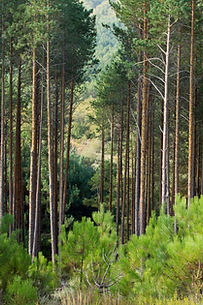
Spotlight on Scots Pine
An Giúis
Pinus sylvestris
Mature trees can grow quite tall – up to 30 metres and can live for more than 150 years. It has a straight trunk and a rounded crown of long green needles. Its bark is bright orange/red, and its leaves are in pairs, two-needled. Pinus sylvestris is the scientific name for the Scots Pine.

Where to find Scots Pine?
It was once abundant in ancient Irish woodlands, especially on high ground and on less fertile soil. It has been planted on marginal land where other species of trees would not survive.
__.jpg)
Leaves
The Scots Pine is an evergreen tree, so it has leaves all year round. They are a deep green colour, finely lined with a bluish-grey hue.
The needles occur in pairs which helps distinguish them from some other pines that have 3 or 5 per bundle and are shorter than most other pines, about 4-7cm.
__.jpg)
Flowers
The tree has both male and female flowers, which are wind-pollinated, so there are no petals to attract insects.
The female flowers are at the tips of the shoots, while the male flowers, which contain the pollen, are further down the shoots.
__.jpg)
Cones
After pollination, the female flowers develop into green closed cones, which open the following year to release the winged pine seeds within.
They are conical when young, becoming more egg-shaped or slightly flattened at maturity.
__.png)
Value to Wildlife
The seeds of the ripe pine cones are the favourite food of the red squirrel, which is well able to extract them from the woody cones.
Bees make propolis from resin that oozes out of cracks in the bark. They use this in their hives to seal and protect cells. It also protects the bees themselves from viruses and bacteria.
There are 91 species of insects that depend on the Scots Pine for their existence.
__.jpg)
Mythology and Symbolism
In the ancient Irish Ogham alphabet, pine represented the first vowel - A. It was also the tree of the second month in the Ogham Tree Calendar, from November 29 to December 26.
As an evergreen, the pine keeps its leaves through the winter. Because it burns brightly, it was associated with festivals welcoming the return of the sun after the winter solstice around 21 December.
In early Irish law, pine was considered to be one of the Nobles of the Wood. This was because resin was collected from the living tree and used for sealing boats by caulking and for preserving wood.
__.jpg)
Bog Deal
Great forests of Scots pine once covered our mountains. Six thousand years ago, the first farmers – the Neolithic people came to Ireland. They brought with them cattle, which needed open land for grazing.
The Scots Pine forests were cleared around this time, due to human influence, and the growth of the blanket bog began where the forests had once been. However, their roots were preserved in the anaerobic acidic substrate.
To this day, the remains of those pine trees, known as bog deal, turn up in those western blanket bogs when they are being cut for turf.
Recent News about Scots Pine in Ireland
Research by botanists from Trinity College Dublin in recent years suggests that the original native Scots pine has been thriving in County Clare for thousands of years and never quite vanished from Ireland.
Scots pine was one of the first trees to colonise Ireland after the ice sheets of the last glaciation finally melted,
some 12,000 years ago. Despite its initial abundance, it gradually declined and disappeared from
most parts of the country about 4,000 years ago. This widespread former abundance of pine is
clearly evident from the pine stumps often exposed through turf cutting.
Scots pine lingered on in a few locations for a further 2,000 years, but was presumed to have disappeared
completely until it was reintroduced from Scotland in the 17th century through planting.
However, a research team led by Professor Fraser Mitchell, of the Quaternary Ecology department at
Trinity’s School of Natural Sciences has indicated that the tree never died out in Co. Clare.
“We analysed pollen grains preserved in lake sediments to look into the natural history of this species, and those grains revealed its continual presence over the years at a location in east Clare”.


